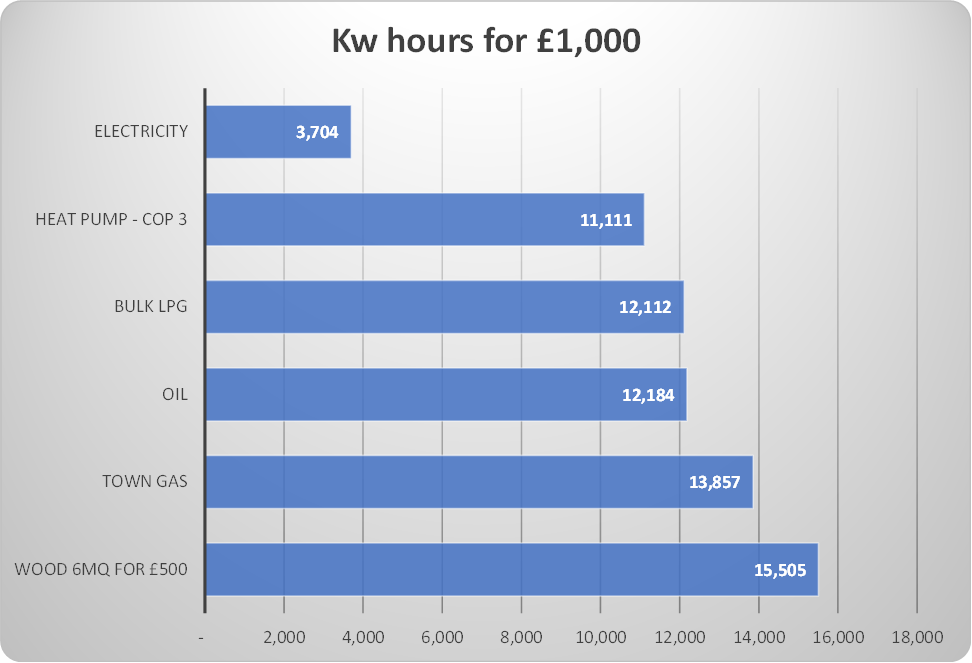There is a hard push under way to make us abandon fossil fuel boilers and adopt heat pumps instead. The trouble is they don’t seem to work for everybody and they are expensive too. So, in many cases that’s a lot of money for something we don’t even want. Don’t despair though, there’s a way through this maze and the outcome could be cheaper heating for less initial outlay. The trick, in a nutshell, is to have more than one heat pump; the one they pay you £7,500 to install and then a smaller one to back it up.
Learn to love heat pumps

Typically consuming not much more power than an electric kettle the heat pump will deliver about 3 times as much energy to your heating, often more. The power is increasingly produced by renewables so the heat pump is an essential multiplier of green energy. That’s why we love them and that’s why we should have them.
Overcome the issues
Heat pumps work well at lower temperatures but that drastically reduces the effectiveness of your existing pipes and radiators. The pipes are the first bottleneck and probably only transmit around 12kW. If you are resisting a total pipes overhaul there is no point in pushing heat pump power beyond 4kW to deliver the 12kW. 6kW delivered is very common and suits well insulated modern houses. With extra back up power that might be the one for you too.
Down the line the radiators will need an overhaul though; either some unsightly bigger ones or, preferably, fan-coil units with smart radiator valves on them to make heat distribution more selective and locally more effective. I prefer my own design for a DIY fan-coil unit (obvs). With a smaller heat pump in the mix the chances are you can cover most of the cost with the £7,500 grant. A good start but now we need more power to back up a system living on the edge.
First things last
Before you start the big overhaul it’s best to install the back-up elements. These will be mini-split heat pumps – those aircon units often found in a hot foreign rental. You probably only need one or two and they are so effective that they should be low power units. The 1.71kW Mitsubishi SRK60ZSX-WF Heat Pump for example bangs out a healthy 6kW. Expect to spend about £2,000 for each one fully installed.
With the heat pump makeover done the running costs will still be the same as oil or gas but now the fun begins as we can move to the cost reduction phase. First off, solar panels. Fitted with Enphase micro inverters you can fit odd numbers in odd places without any problems and they should give 20 years of trouble-free power. Because your heat pumps are low powered you will often find you can run one for free even when panel output is reduced. Include a solar diverter (like the Eddi) and the panels can send their surplus power to the immersion heater. This fixes the problem of poor hot water delivery associated with low temperature heat pumps and is the reason you might get away with not changing the tank in the first place. Keep your old tank, spend the money on panels. Now the heating and electricity bills are usefully reduced and maybe servicing costs too. Do you service your fridge every year? No; same for heat pumps.
What about batteries? They used to be expensive and they wore out too quickly to justify the cost. But now they are cheaper (check out the Fogstar site) there is a good case for storing cheap off-peak electricity and running your (low powered) heat pump on it later. This can literally halve your energy bills – see graph below.
There’s a useful tactic to be considered when you are finally persuaded into owning an electric car.
Some EVs can offer 240v vehicle to load (V2L) with around 3kW available from a socket behind the back seat. They imagine you might plug in a toaster when you go camping. So, never mind the toaster, you could plug in a mini-split and use cheap off-peak electricity to heat the house. If you are looking for a box of tricks to make this work check out the Victron Quattro-II which has an extra 240v input. The idea here is to go for a domestic battery first but be ready for the EV when it comes.
This all gets you connected to super cheap heating and air-conditioning too.

As you can see, cheap off-peak electricity, time shifted then multiplied with a heat pump gives astonishing results. Vehicle to Grid charging is another way although not yet mainstream but V2L gets us there now without installing the expensive V2G charger and you can choose from a bigger range of cars. So not a Nissan Leaf now, more likely a Kia or Hyundai. The result; half price for a lot of your heating if not all of it.
Of course, all houses are different but hopefully there are some ideas here to help make a complex topic simpler. Small heat pump + mini-split + solar – the way to go – then batteries.


Leave a comment